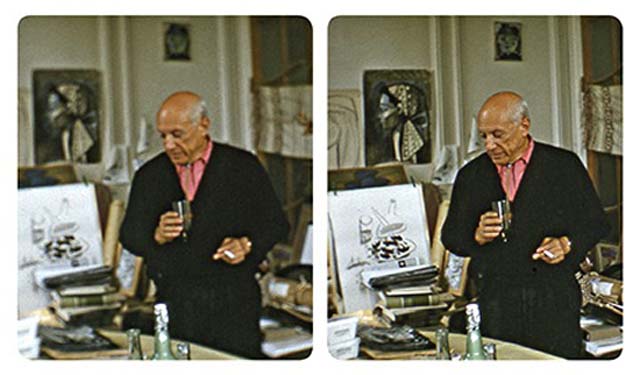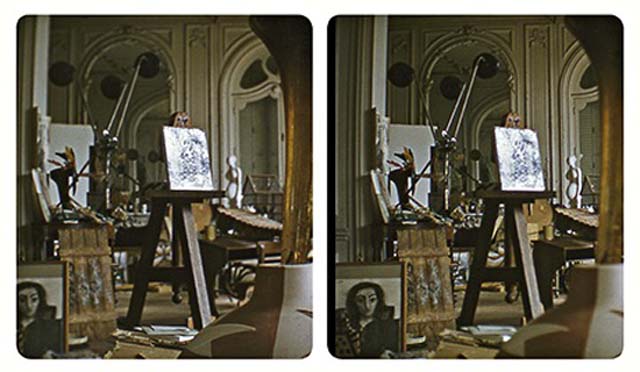SEE ALSO BRIAN’S SOAPBOX
Brian has been assisting with this project. READ ON…
GUARDIAN
Holburne Museum show of stereoscopic images of artist at height of his fame gets a little help from Brian May 8 February 2014 by Mark Brown, arts correspondent

They show Picasso with his admiring entourage, relaxing with his family and friends, posing in his crazily cluttered studio, proudly wearing the stetson given to him by a Hollywood actor and being mobbed as a superstar at the French bullfights he enjoyed. And all are in 3D, part of an exhibition where the images will be shown for the first time. The images date from 1957, when Picasso was acknowledged as the world’s greatest living artist, and will be displayed at the Holburne Museum in Bath, where visitors will be able to see them on 3D TV screens by wearing special glasses or through viewers.
Alexander Sturgis, Holburne’s director, said the Picasso images were one part of “a fantastically varied and extraordinary archive”, taken by Robert Mouzillat – a brilliant and eccentric 3D technology pioneer and inventor of the two-lens camera which took them. Sturgis was first approached by his daughter, Elizabeth Mouzillat Jowett, and he happily travelled to Jersey to look through the 100,000 images that exist there in the archive.

There were pictures of monuments, French landscapes, nudes, the inside of the Elysée Palace, the coronation, even Arnold Palmer and his golf swing. But “the ones that leapt out were this extraordinary group of Picasso photographs,” said Sturgis. “It is not every day that one finds a group of photographs of Picasso that no one has seen before.”
To see Picasso’s enormous studio was particularly fascinating. “It really is rather amazing. They are my favourite images, even the ones he’s not in. You get a sense of the space and the room and this mix of his art, other people’s art and then just clutter … rubbish,” said Sturgis.
In 1957 the 75-year-old Picasso was at the height of his fame. Sturgis said: “He is universally recognised as the world’s greatest living artist and there were people hammering on his door day and night wanting an audience with him.” The fact that Mouzillat was invited to the artist’s home, La Californie, near Cannes, was a measure of Picasso’s interest in what might have sounded a slightly madcap proposition. While there, Mouzillat took pictures of other weekend guests such as Jean Cocteau, the Spanish surrealist artist Jaime Sabartes and Picasso’s biographer John Richardson. There are images of Picasso’s family – including his wife Jacqueline Rocque – and the menagerie of pets: Lump his dachshund, Yan his boxer and Esmerelda the goat.
There are also images of Picasso at the bullring in Arles, where he was mobbed, and one particularly striking one of him wearing a stetson given to him by Gary Cooper from the best forgotten 1945 film Saratoga Trunk in which he starred as Texas gambler Clinton Maroon.
Sturgis said: “It is an important period and well documented but these images provide a completely new, well a literally new, perspective.”

Richardson has written a foreword for a book accompanying the exhibition in which he recalls how the people of Arles celebrated the opening of the French bullfighting season. “Picasso enjoyed presiding over these tauromachic festivities. Before the corrida, he had invited a group of us to lunch at the Hôtel Jules César. He introduced us to a new friend, Robert Mouzillat, whose amazing discoveries in three-dimensional photography had fascinated Picasso.”
The gallery has been helped in the project by a somewhat unusual source. Sturgis said he got in touch with Brian May who, as well as being Queen guitarist, astrophysicist and friend of the badgers, is chairman of the Stereoscopic Society. May called it an “absolutely fabulous project” and has prepared the images in the book that can be seen through the London Stereoscopic Company’s ‘Owl’ viewer. May, responsible for two books of stereoscopic photography from the 19th century, had been “an extraordinary help”, said Sturgis. “He was immediately and incredibly helpfully responsive in a way you don’t expect of rock gods.”
Mouzillat was a fascinating man who lived a long and rich life. Born in Suresne in 1913, he joined the French ministry of internal affairs in 1938 and was active in the resistance during the war. In 1945 he was part of De Gaulle’s delegation at the first peace conference in San Francisco and in 1947 he became a director of Pan Books. But technology was his abiding passion and obsession, said his daughter Elizabeth. He died in 2010 although his later years were blighted by Alzheimer’s. He always knew that the current interest in 3D would come, she said. “He was a pioneer and way ahead of his time really.”
• Stereoscopic Photographs of Pablo Picasso is at the Holburne Museum, Bath, from 22 February to 1 June.
HOLBURNE MUSEUM
22 February 2014 – 1 June 2014
Stereoscopic Photographs of Pablo Picasso by Robert Mouzillat
Wirth Gallery | Free
This exhibition presents, for the first time, a small part of an extraordinary collection of colour stereoscopic photographs of Picasso taken over the Easter weekend of 1957 by the pioneering 3D photographer Robert Mouzillat. These amazing photographs of Picasso were taken at his request at the height of his fame when he was curious to know how his works would look in 3D. The photographer, Robert Mouzillat, was a celebrated French publisher, brilliant inventor and captivating eccentric who had, with his engineer father, perfected a ground-breaking 3D camera in the 1940s. This collection provides a unique, intimate and vivid record of Picasso at home, in his studio and garden, and at the bullring in Arles, France.
The quality of the photographs is outstanding. They show Picasso with famous friends, family and admirers. These include his son, Paolo, and Jacqueline Rocque whom Picasso married in 1961. Also John Richardson, his official biographer, Jaime Sabartés, Spanish surrealist, Jean Cocteau, French writer and film producer, and similarly well-known people close to Picasso.